An explanation of what I’m doing here can be found in my introduction post.
Last week’s look at NHL FaceOff, Hi-Octane, Thunderstrike 2, and Shockwave Assault can be found here.
This week, we’ll look at Jupiter Strike, Geom Cube, Loaded, and Gex.
**This post was originally published on 10/19/2022 on Giant Bomb dot com**
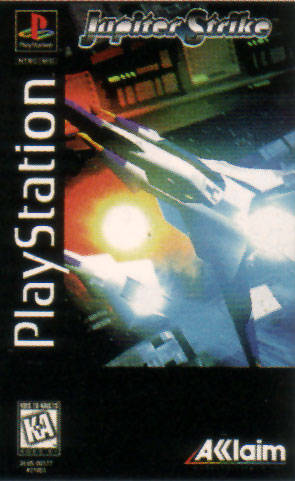
Jupiter Strike
Release Date: 12/6/1995
Developer: Taito Corporation
Publisher: Acclaim Entertainment
Time to Bored and Frustrated: 30 Minutes
We start this week with our first made-for-Playstation Rail Shooter! Our reward for making it to this point is in-engine rendering of the environment, and thus sane hitboxes. That’s where my positivity ends, however. This is also almost where my thoughts on this thing end, but let’s give this a try and see what happens.
Jupiter Strike comes to us curtesy of Taito, which isn’t a name you hear that often these days. There’s a reason for that. Taito was one of the earliest arcade developers and publishers, with their biggest hit being Space Invaders. In spite of being the frickin’ space invaders guys, the company was starting to run out of gas by 1995 with the Darius and Bubble Bobble series starting to wind down. For context, we’re about 10 years away at this point from Taito getting absorbed by Square Enix. I recommend reading up on Taito and its weird history. So, what do we get as the first Playstation exclusive from this old and venerable developer? An aggressively mediocre rail-shooter where you fly a little spaceship through the solar system fighting off a random alien invasion. Thankfully, this game plays closer to Panzer Dragoon, which was the best rail shooter of the time, than the various 3DO and Sega CD pieces of crap we’ve been seeing, so there’s that.
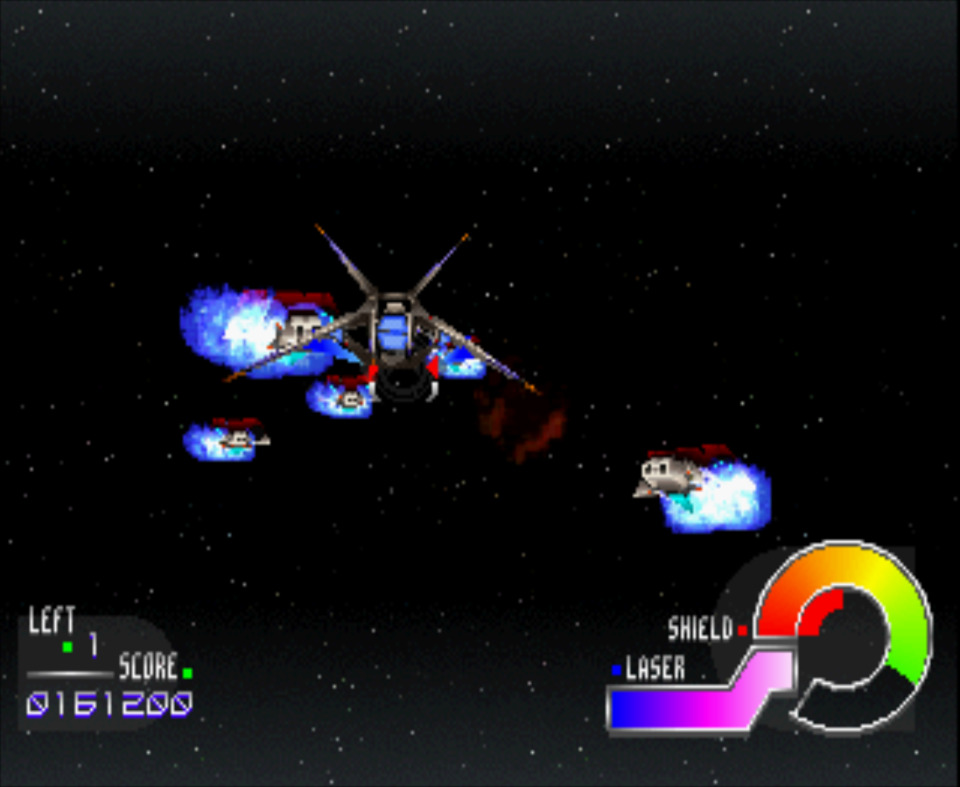
The levels in this game are divided into multiple worlds, each with four stages and a boss fight. Your weapons include an infinite ammo pea shooter and a multi-target lock-on that consumes a rechargeable energy bar. All of the enemies and objects are polygonal, which feels better than if they were pre-rendered but causes the whole package to look blurrier. The UI is sensible and easy enough to read, which is always nice, and the music is unremarkable.
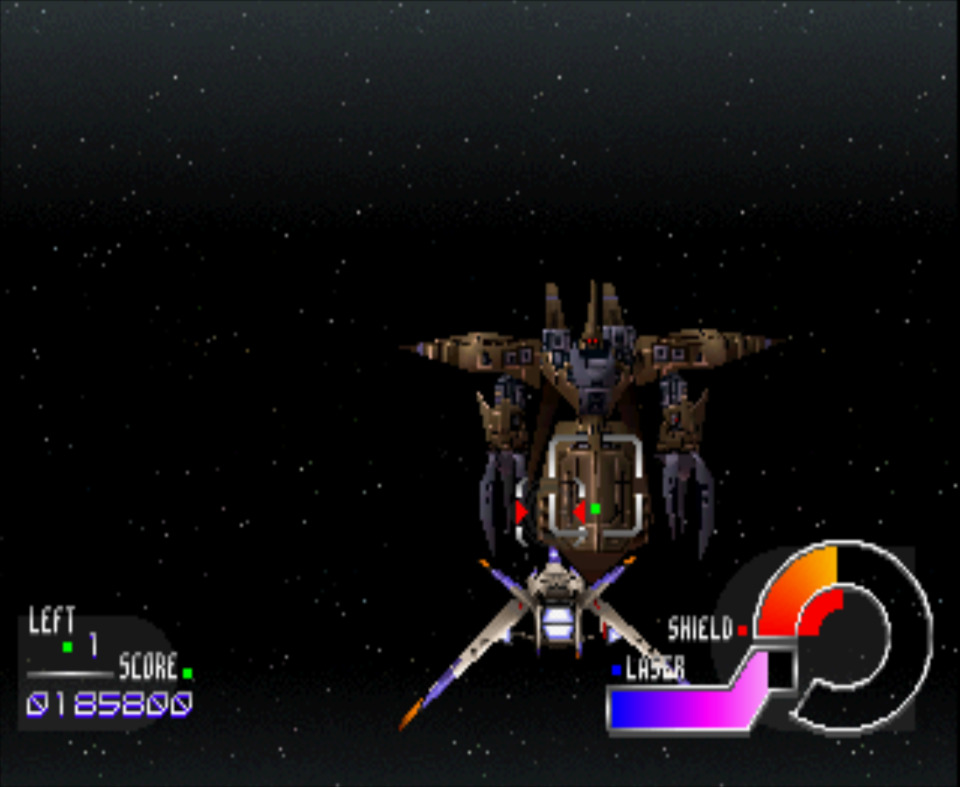
In spite of those otherwise promising points, the experience falls over from fatally flawed gameplay design. First, there are no power-ups of any kind. The player’s power is constant and there are no additional weapons to play around with. There also doesn’t seem to be a way to regain health or additional lives. You shoot with the two provided weapons, dodge attacks, and nothing more. Second, the boss fights take way too long for their limited attack patterns. The bosses have only a handful of attacks that they commit in a predictably specific order, and their weak points are only made available briefly which exacerbates the incredible amounts of health they have. This causes the fights to be drawn out well past the amount of interest or entertainment they could provide. This is all made worse by the strict lives system of five continues with five lives each. 25 lives sounds like plenty, but when losing a life in a game with lengthy levels and no checkpoints, which also throws lots of bullshit at you without any ability to heal, that number is nowhere near enough. This system is all the more perverse for the duel reasons that the punishment for using a continue is the same as using a life and the fact that this game was never at any point released in arcades, meaning that having continues serves absolutely no purpose.
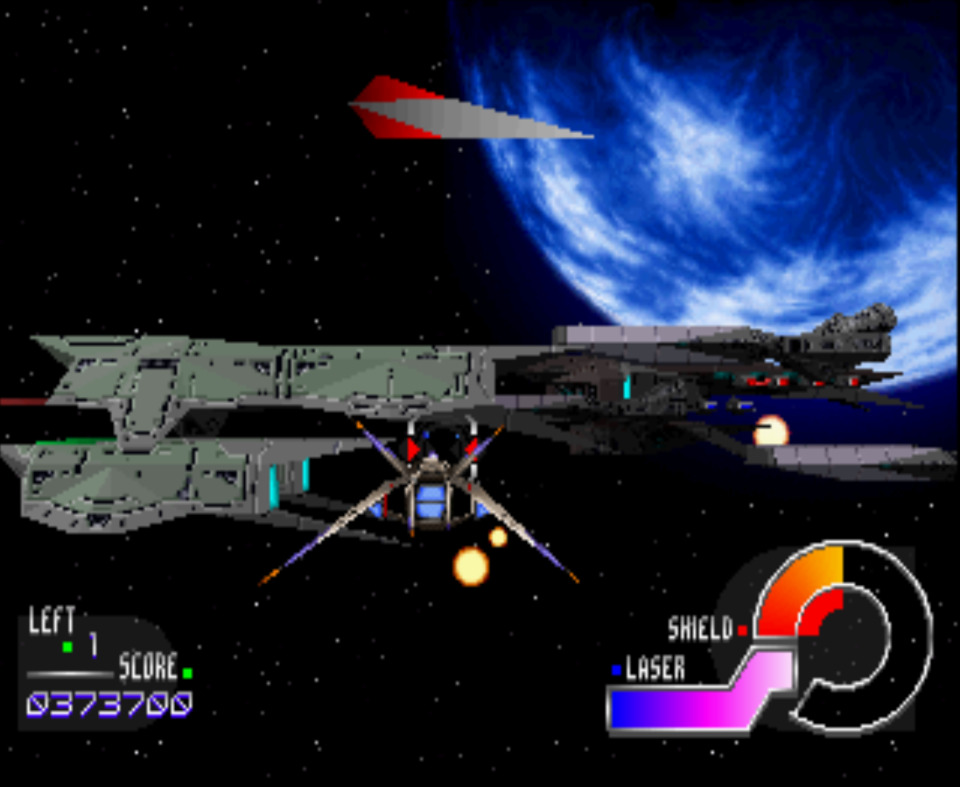
Practically, the combination of these issues means that the game requires nothing more or less of the player than rote memorization and patience. This might as well be a NES game. That wouldn’t be a dealbreaker if the core gameplay loop was fun. Sadly, the movement feels sluggish and the aiming is finicky. That’s on top of severe pop-in and a highly variable framerate. The core gameplay feels like a chore, and the game makes no successful attempts to give players any reason to put up with it.
This thing would make a ton of sense if it originally came out in arcades in like 1993 or something. Instead, it’s a single player only exclusive game for the Playstation. I suppose it makes sense then that this comes from Taito. Maybe the team that worked on it was their arcade action game team, and this design was all they knew how to do. Over the mid-to-late 90’s we’re going to rapidly outgrow old arcade standards of game design. Games like Jupiter Strike, which feel like they would have been also-rans in early-90’s arcades, are going to be less than inadequate even by the time we get to 1997. I look forward to this kind of console game dying off the further we get into this project.

Geom Cube
Release Date: 12/10/1995
Developer: Technos Japan
Publisher: Technos
Time to Owned By Lisa: 35 Minutes
This one’s the kind of weird little swing-and-a-miss that I appreciate stumbling upon. The creative process for this game seems to have begun and ended at, “what if Tetris was 3D?” The developers didn’t seem to land on a good way of portraying a 3-dimensional Tetris, though in their defense I don’t think anyone ever has.
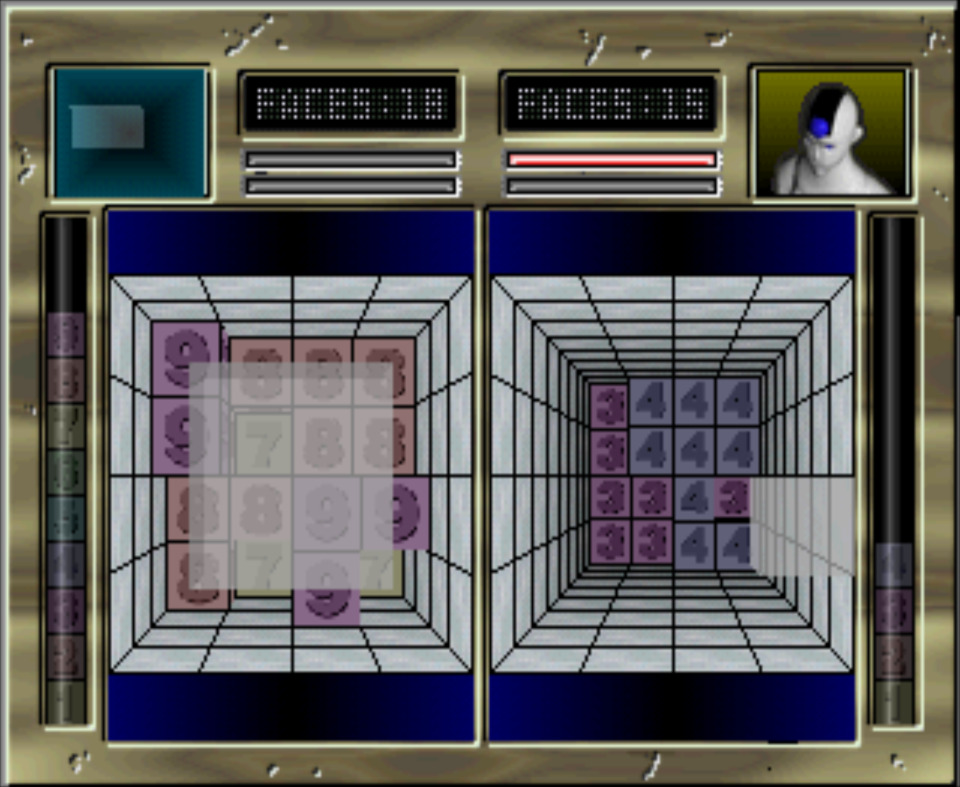
What we do have is a design that is derivative of a couple of the other failed attempts at 3D tetris, which involves controlling literal 3D interpretations of tetriminos from a top down view of a puzzle tower. The obvious lack of depth perception is addressed by having each stack of blocks show the number of the height of that stack, and by having the different layers be color-coded. That was probably all they could have done without making a real 3D playing field; but in practice, this turns the whole thing into a number puzzle game more than a Tetris game. In order to place pieces onto the game board, they need to be manipulated along three axes, with a different button spinning a piece in one direction along one of those axes. That means that the player needs to use six buttons for piece spinning as opposed to two in normal Tetris. This adds a layer of brain mis-wiring for what I assume would be most players, and because of this I was unable to get a proper feel for which buttons would get pieces into the positions that I wanted. The game turned into quickly turning a Picross-looking number field into a 3D space in my head, figuring out where the current piece would fit in that 3D space, and wrestling with the controls to get the piece into that position. Getting that thought process down takes a lot of mental re-training from skills built up by more rational puzzle games.
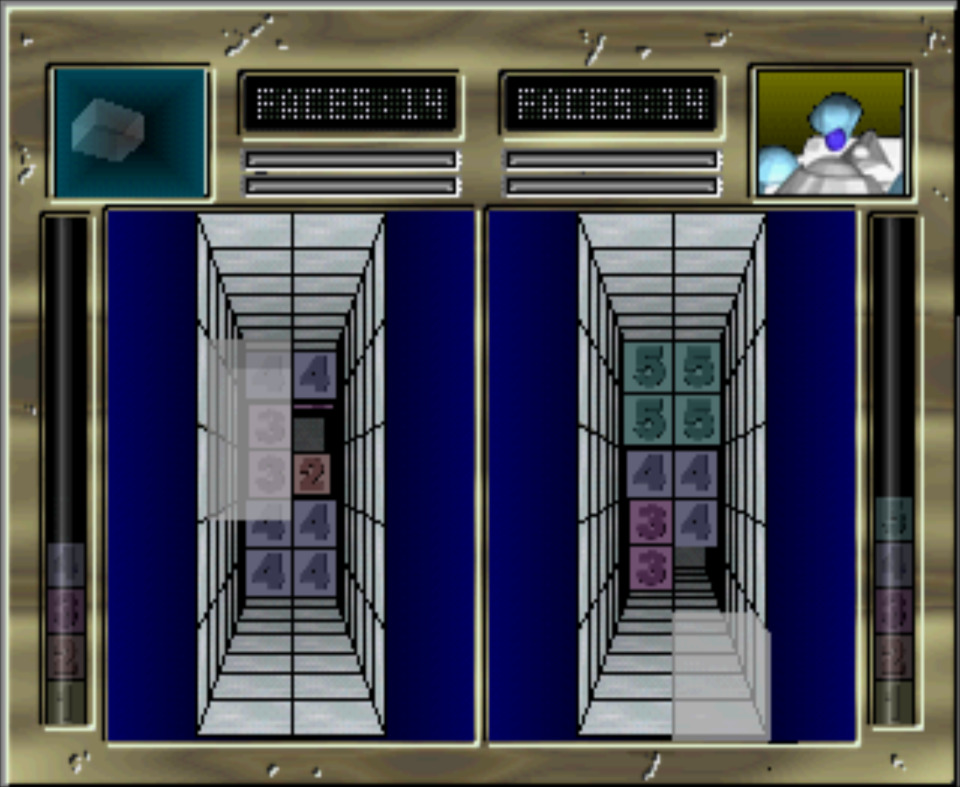
The un-intuitiveness is compounded by the fact that the main mode is battle tetris. So, this necessary skillset is learned while getting spanked by AI opponents, which I guess is standard for 90’s games. There is a normal single-player mode that can be used for practice, but I found it incredibly dull. I eventually made it a few battles into the fight ladder before calling it a day. There are also features which are missing that are vital to an enjoyable tetris experience: there’s no hold mechanic and the battle mode has no next-piece-preview. That combined with the inherent difficulty of getting clears on 2-dimensional grids instead of 1-dimensional lines means that once a match starts to run away from you in the slightest amount, there isn’t really any way to recover, and everything gets out of control very quickly. This means that, at a casual level of play, whether you win or lose a round depends more on the luck of piece generation than it would in any standard Tetris game. In the end, even though I had picked up on the basic gameplay strategy and was given a seemingly infinite number of retries, I had grown frustrated and this thing had given me a headache. Which is too bad, it’s a weird idea executed with relatively clean visuals and a soundtrack that kinda jams.
The design shortcomings make sense when put into proper context. Apparently, Technos was only a few months from total bankruptcy when this game got its American release. It even seems like there were only a handful of additional releases between this game and the end. This is now the second game in a row we’ve seen from a venerable Japanese arcade developer on its down-swing. This is the studio that made Double Dragon and River City Ransom for crying out loud, and this is one of the last original IPs they produced before being shuffled into the dustbin of history. As the back half of the ’90’s go on I think we’re going to see more arcade developers fall to the void, which I suspect will correspond 1-to-1 with the rise of modern console game design and the decline of arcade style games. I’m keeping an eye on the unfolding of this process.
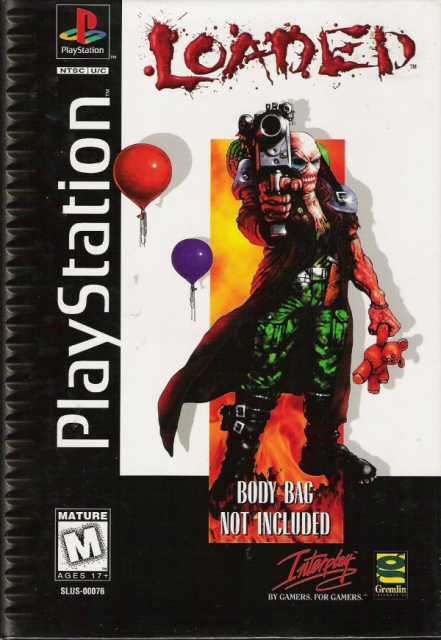
Loaded
Release Date: 12/12/1995
Developer: Gremlin Interactive
Publisher: Interplay
Time to Nibbled By Rats: 50 Minutes
What little I saw online about this game before I played it really made me reticent to even give this thing a try. I’ve complained before about the faux-angsty edgelord horseshit of this cultural era as it’s popped up in previous PS1 games. Well, I’m now being punished for something I did in a past life, because I’ve been saddled with the most faux-edgy hunk of trash I have yet seen on the PS1.
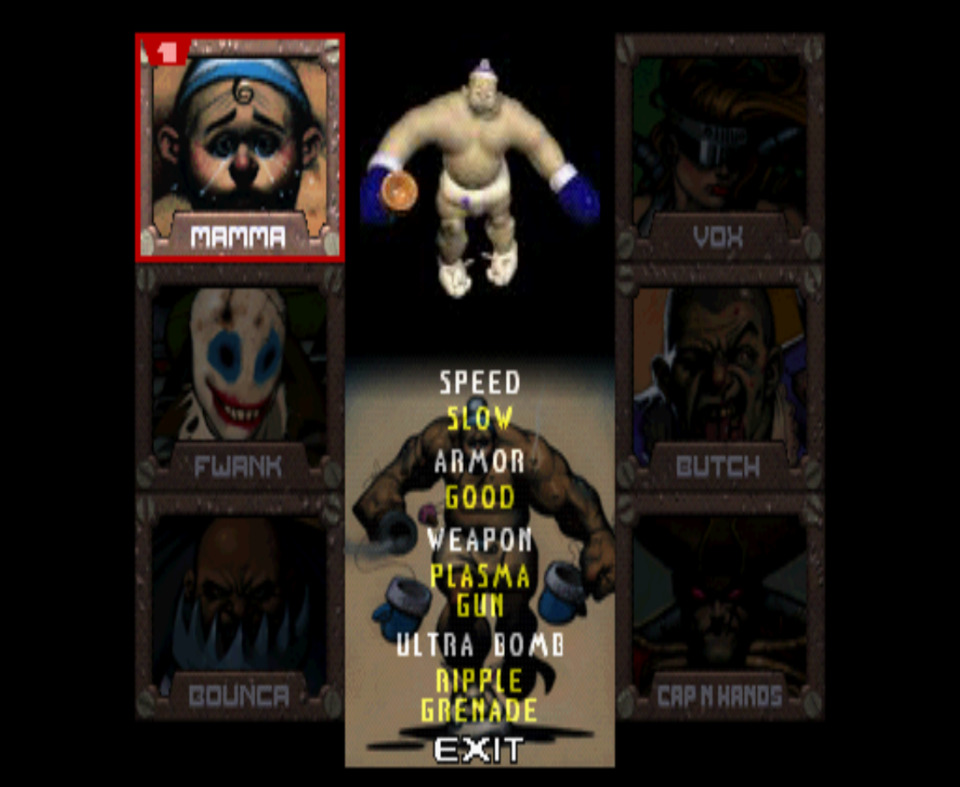
Starting from the top, Loaded is a top-down dungeon crawler that plays like a cross between Gauntlet and Smash TV with a dash of keycard maze level design from Doom. This is a dual-joystick shooter before dual-joystick controls were a thing, which is inherently unfortunate. The gameplay basically works okay enough, despite some inherent design problems that I’ll get to. The thing that really kills this thing is its lore and “style”. I really do not recommend looking up the story of this game because Jesus Fucking Christ. The best thing I can say is that almost none of the lore is actually made apparent during the gameplay experience. What is present of the wider story is told in the little tidbits we get when we choose one of the playable characters. Here we see the kind of worldview that we previously glimpsed in Twisted Metal taken to a more severe extent. The selectable characters are: Literal Man Baby With a Diaper and Everything, Insane Clown With Exploding Teddy Bears, Biggest Fucker in a Tuxedo, The Woman, Guy in a Dress, and Cyborg Pirate With Cartoonishly Sized Hands. All of these characters start off in a maximum security prison gone awry, because they happen to be the most hyper-violent psychos in the galaxy. Oh, this is technically a sci-fi game set on another planet for what that’s worth. Don’t look it up.
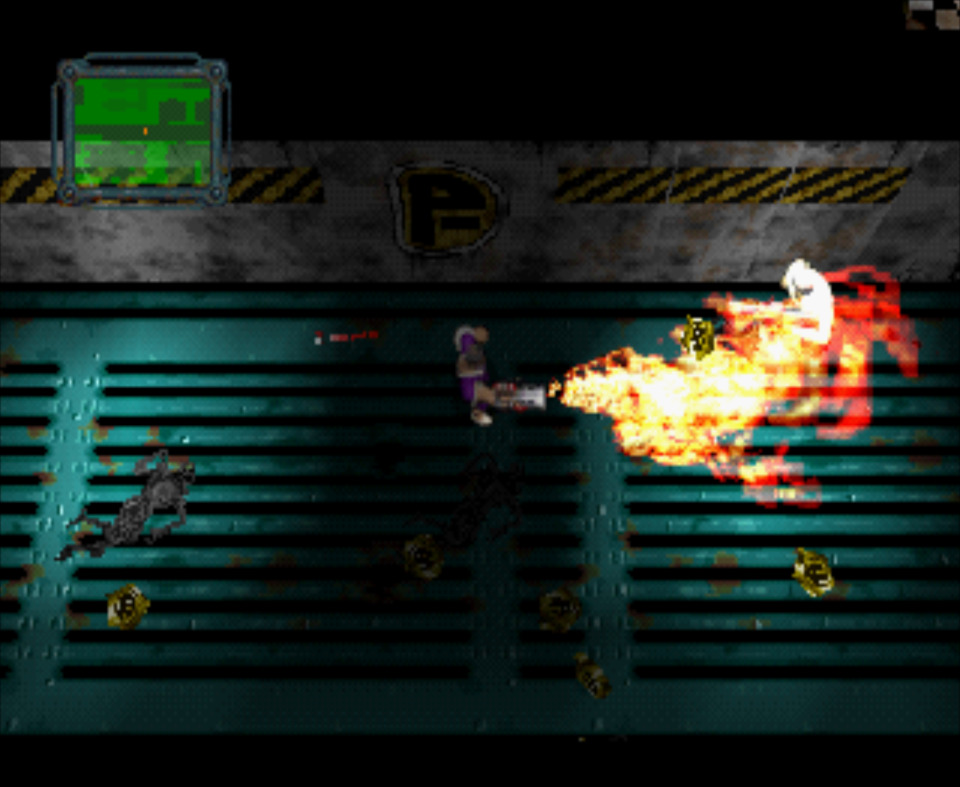
This game is also supposed to be comedic, and if your sense of humor involves homophobia and laughing at the disabled, then it will be right up your alley. Also, if that is your sense of humor: go [redacted]. If you’re thinking that I’m being histrionic, know that the difficulty settings are named using a pattern of “Players are ____”, with the lowest difficulty setting called “Players are Fairies”, which would have appealed to people who thought that Doom wasn’t rude enough for them. This all makes some sense when seeing that the story and art design were contributed by some 2000AD shitlords. Most notably by Garth Ennis, who on top of being a right wanker was also later responsible for The Boys. And you know what, I can see the progression of sensibility. And if it was just one or two things about this game that were trash, I wouldn’t be spending this much time talking about it. If the lore was less heinous but the characters were still this way, it would only just be mildly obnoxious like Twisted Metal. If it called the players a slur but had less “personality” in the selectable characters, then it might skate by. But all of this taken together signals intent to be an asshole, so I will treat this game like it’s an asshole.
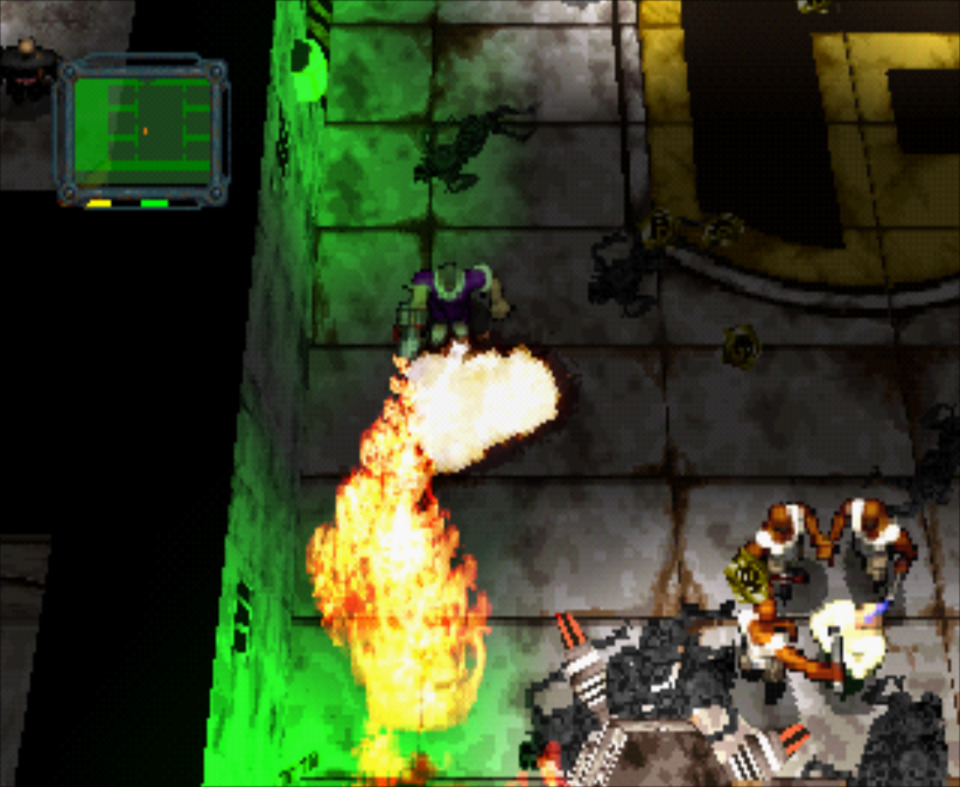
Though, having an eye-catching aesthetic, even if it’s eye-catching for the wrong reasons, was the right call for this game because the actual gameplay is quite dull. The keycard-maze level design is uninspired, the visual themes and variety of the enemies are so-so, and combat feels like an uninspired take on Smash TV. Each character has one weapon and one type of screen clear attack, which becomes mundane very quickly. There are pick-ups for health, ammo, and weapon power upgrades, but they’re kinda sparse. Even then, the upgrades only add incremental area-of-effect and damage buffs, so nothing exciting there. The experience is further downgraded from basic to middling by a few design quirks. First, not all of the characters have weapons that fire from their centerline. That sounds very minor but imagine playing a dual-stick shooter and having your one stream of projectiles firing from just to the right of your character. This makes aiming trickier than it should be and gives a blind spot for melee enemies to run up to your face and shank you without you having the ability to respond or prevent it. So, there are some unusable characters, but the rest work properly. Next, the camera isn’t at a 90-degree top down angle, but slightly isometric, meaning that in the many tight corridors, enemies can be hidden against the wall facing away from the camera. This is a common issue in isometric games, though Loaded makes no effort to address it. Finally, this slapdash piece of crap doesn’t even have a save system, but instead runs on end-of-level passwords. I have a rant building up in me about password systems, but I’ll save that for another time.
The levels containing this uninteresting gameplay are also visually uninteresting. The first two take place in a typically edgy murder prison and the third is a sewer level. That level introduces infinitely spawning rats that move too fast to be effectively killed without wasting ammo, meaning that I ultimately ran out of both ammo and lives via getting nibbled on by an infinite horde of rats.
The worst thing for a piece of media setting out to be rude is to end up being dull. That’s what this game is, all edge and no point. But that edge is also as sharp as a toy plastic knife. I was made more tired than angry by this thing. There are no redeeming qualities to be had here, and it deserves to be forgotten.

Gex
Release Date: 12/13/1995
Developer: Crystal Dynamics
Publisher: Crystal Dynamics
Time to [Insert Poorly Aged Reference]: 30 Minutes
Speaking of questionable “humor”, we now have to deal with Gex in all its glory. Let’s start with that humor. The namesake character of Gex is a talking Gecko with obviously fake ‘tude who is voiced by Dana Gould. I had not encountered Gould or any of his work before this game, and from a little research it seems like he’s the last of those old-timey “take my wife, PLEASE!” type of comedians. Maybe he had some genius bits that aren’t immediately available on YouTube, but what I saw was uninspired and old hat even for the ’90’s. Now, you don’t get a comedian, even a mediocre one, to voice your character without having them do jokes. In this case, those jokes are all one-liners that are spammed incessantly throughout the game. I’ll get to how this impacts the experience later on. For now, I’ll say that I don’t know whether my nemeses at Crystal Dynamics had Gould do ad-lib riffs on the game or whether he was acting off of prepared lines; but whichever one of those scenarios was the case, they should have done the opposite.
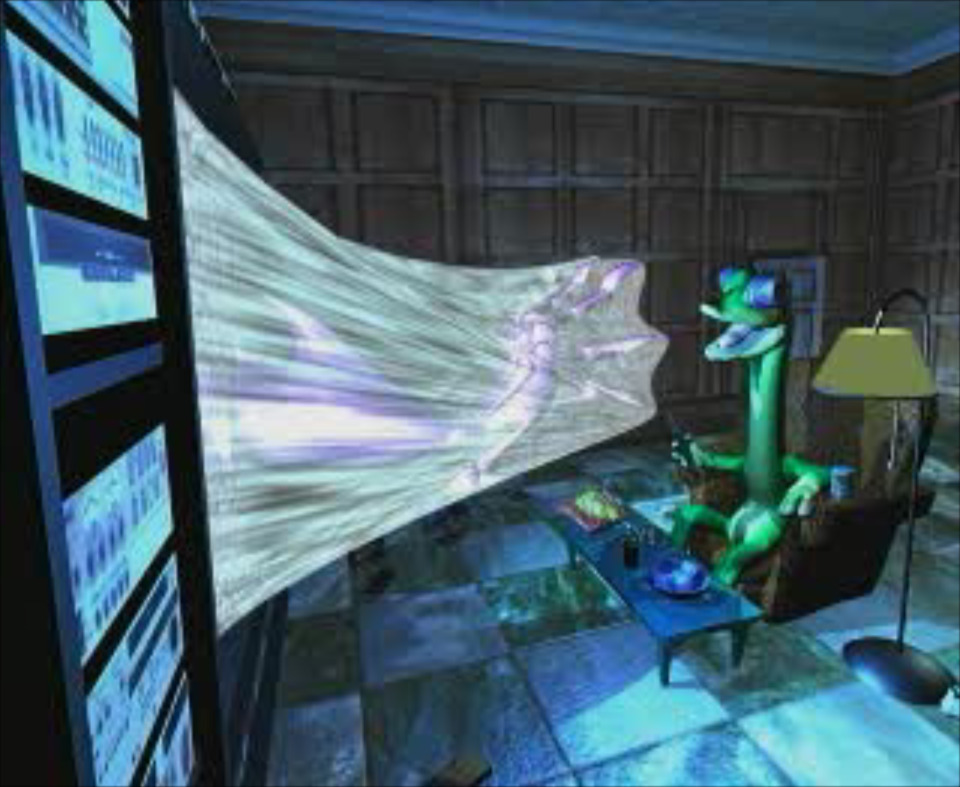
The biggest problem with the jokes stem from the game’s premise. It opens with Gex relaxing in front of his TV after a session of “nude funkercise” (typing that made me want to die) and is suddenly grabbed by his TV screen and dragged into a TV world. I guess we now know where Persona 4 got the idea. He of course needs to get out of the TV, and he does so by traversing through a handful of worlds that are each based on different popular TV/movie genres. The only world I saw is based on tired Horror tropes, and I imagine the other levels treat their genres similarly. The wisecracks that get spouted by Gex are referential of other, better, pieces of media and are usually relevant to the current genre or are just pop culture references in general. This is sub-Family Guy tier referential humor, such as the possible lines that play when Gex breaks a flying TV set: “This is for 12 years of Full House!” or “Hey, look, SNL.” The lines are never funny and sometimes a bit questionable, such as when he compares female monsters to his ex-wife. Though to be fair, that last example is pretty much Gould’s entire shtick. It’s all bad and off-putting, and lines get spouted almost constantly during levels, which starts off as grating but probably becomes background noise after playing for long enough.
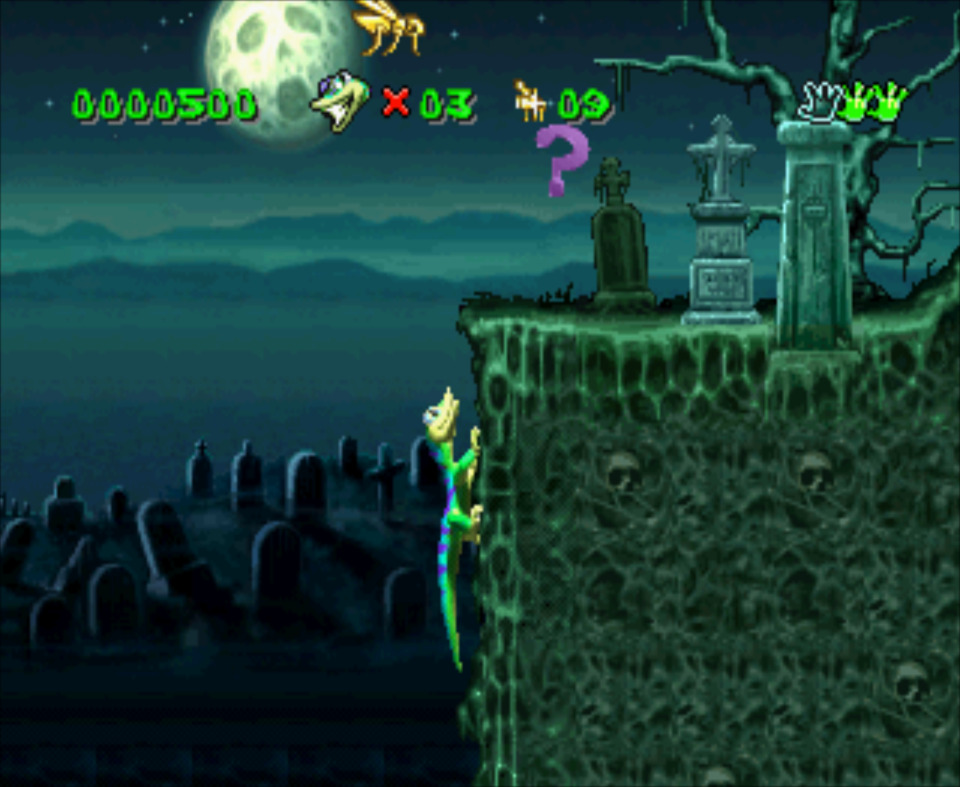
Speaking of the levels, the game itself is a standard 2D Platformer with a couple of traversal gimmicks. You walk to the right, jump over obstacles, hit enemies with a tail attack, and eat power-ups with a tongue attack. The aforementioned gimmicks are that, being a gecko, Gex can cling to certain walls and ceilings in order to get around. There’s even a Mario World style wall-crawling mechanic where he moves around on a wall parallel to the camera. In the four levels that I played before running out of lives, there were some instances of genuine game design and best practices that shone through the crap-ass aesthetics. That fact alone puts this game above something like Rayman, which feels like it was designed by an inept space alien.
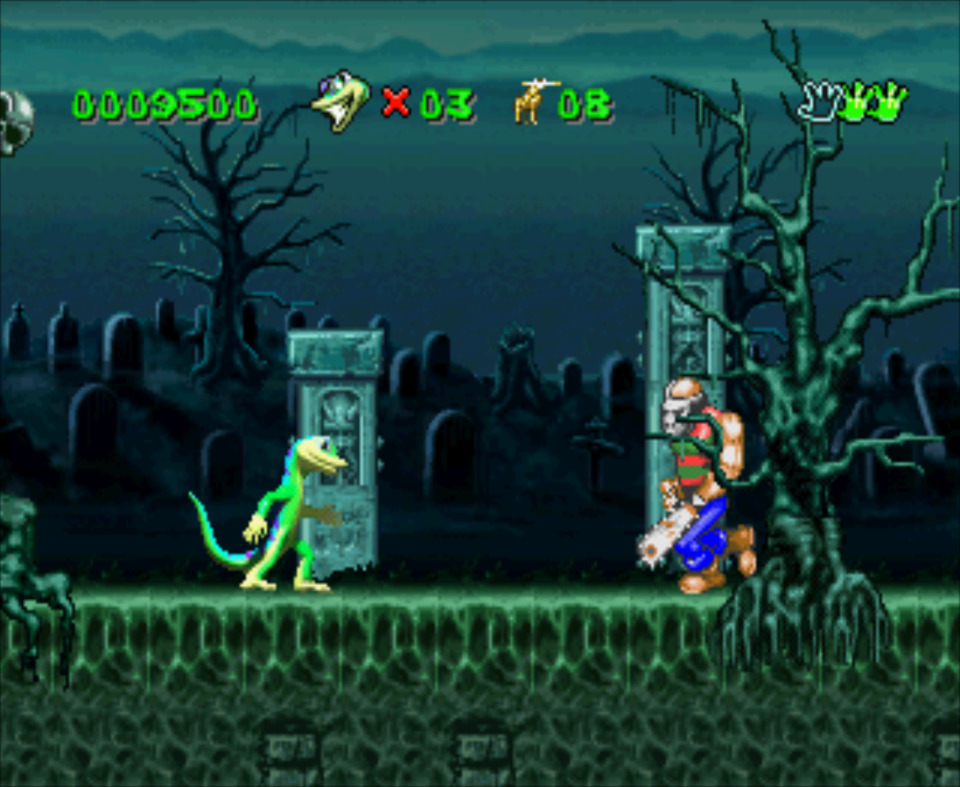
This is where my positivity ends, as I go back to the lives system: The game is fairly generous with handing out 1-ups, but there are no continues, so when you run out of lives it’s back to the title screen. There also isn’t a save system in this thing. Instead you collect missable in-game items which give you passwords and if you get booted back to the menu, you better have one of those passwords or you’re starting fresh. This is like a four or five hour game with long levels and no ability to save. That’s an absolutely psychotic design decision given the existence of memory cards, and is the main reason I bounced off this game after only half-an-hour. There really is nothing to recommend this thing other than the almost competent level design, but there are so many platformers with almost competent design and more interesting styles that this game is an also-ran among also-rans.
That leaves us confronting why this game is even something that we have to deal with on the PS1. This feels like it could have very easily been a Genesis or Sega CD game and it benefits not at all from the PS1 hardware. Turns out, Gex was supposed to be the platformer mascot for the 3DO. That’s right, this damnable thing is another 3DO port. In fact, it might be the 3DO port considering this was originally supposed to compete with Mario and Sonic. This accursed piece of crap is even supposed to be the highest selling 3DO game of all time, so it’s very telling that it got ported to the Playstation mere months after its original release. This port has to be one of the nails in the 3DO’s coffin, though I’m not sure whether it was the final nail. Hopefully the influx of 3DO cast-offs will slow down in 1996, because these things are taking a toll on my health.
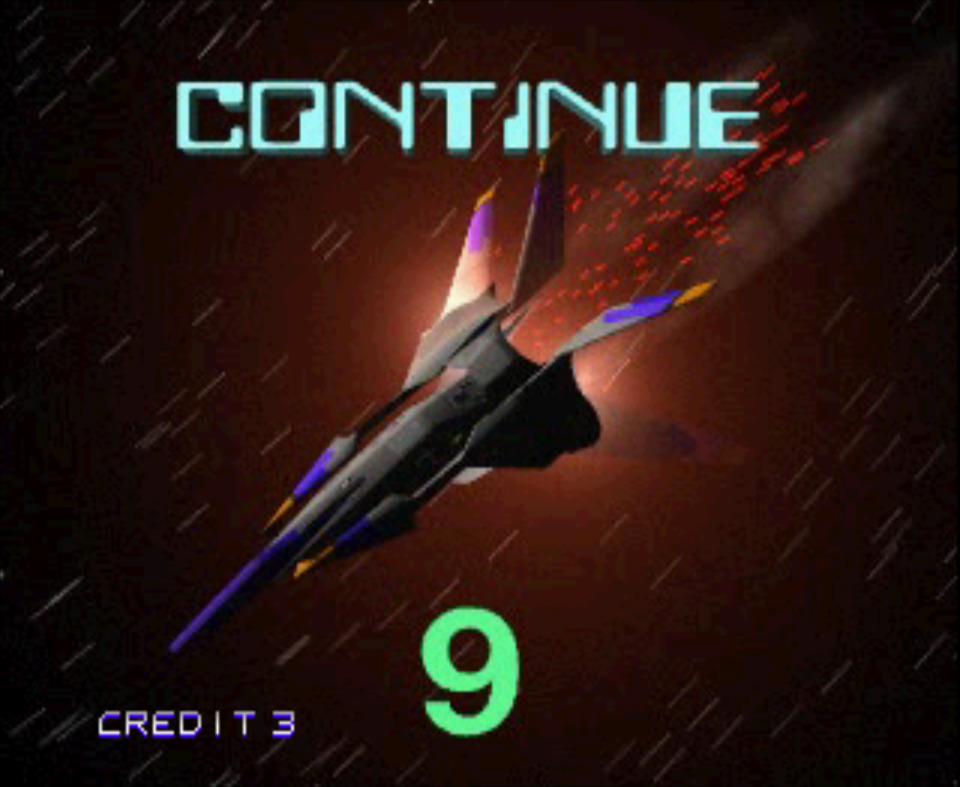
Next time we’ll reach the end of 1995, and what I am going to consider the launch window for the PS1, when we look at NBA in the Zone, Zero Divide, Bases Loaded ’96: Double Header, and finally Road Rash of all things.
Leave a comment